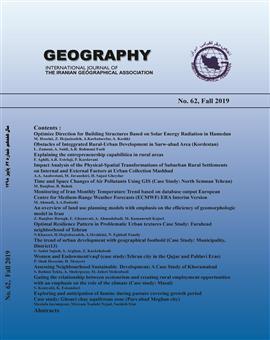Functional features and limitations of urban-rural constellations as functional regions The Case of Zia-abad (Qazwin))
Subject Areas :seyedeh Kinaz Mahmoodi 1 , Abbas Saidi 2 , Hasan Afrakhteh 3 , Farhad Azizpour 4
1 -
2 -
3 -
4 -
Keywords: Rural-urban Contellation Region Functional Region Integrated Rural-urban Development Zia-abad Qazwin,
Abstract :
One of the serious issues of spatial planning is to determine planning regions at different levels and on different scales. Hence, in most cases, the boundaries of administrative units or even their composition are the basis for measures. It can be argued that the fundamental problem arises when the question of planning is raised at the micro and lower levels of the provinces and districts, in the formal sub-regions and areas. The concept of the "constellation" has emerged in recent years as an alternative to these small levels of spatial planning, which represents the "district" unit. The key question in this regard is to what extent does the delimitation of the administrative divisions, which are often based on political considerations, conform to the requirements of planning? And can these units be considered as "functional regions"? In this context, this paper attempts to study these issues by considering the District Zia-Abad of Qazvin as a case study, while investigating these problems, using qualitative methods of discussion and relying on the “structural-functional dynamics” approach, to identify the opportunities and barriers to the formation of functional regions at the micro level, and the effectiveness of this level of space arena in the form of such administrative subdivisions. The results of the study show that the efficiency of constellations as functional regions depends not only on the deliberation of subdivisions, but also on the modification of infrastructure, the associated investments and effective support in the allocation of facilities and credits, the proper condition for the interaction and the functionality of existing settlements at the constellation level
-پژوهشکدة علوم محیطی دانشگاه شهید بهشتی (1397)، به روزرسانی مطالعات آمایش استان قزوین؛
- درگاه ملی آمار، نتایج سرشماریهای عمومی سالهای 1335 تا 1395؛
- درگاه ملی آمار، سرشماری کشاورزی 1393، استان قزوین؛
- سازمان برنامه و بودجه استان قزوین (1376)، آمارنامة استان قزوین؛
- سازمان مدیریت و برنامهریزی استان قزوین (1398)، سند اجرایی آمایش استان قزوین، شورای برنامهریزی و توسعة استان قزوین؛
- سعیدی، عباس (1355)، ضیاءآباد: بررسی شتابزدة یک روستا، دانشگاه ملی ایران، دانشکدة ادبیات و علوم انسانی، پایاننامة کارشناسی ارشد جغرافیای طبیعی (استاد راهنما: دکتر ایرانپور جزنی)؛
- سعیدی، عباس (1385)، "روابط شهر و روستا و پيوندهاي روستايي- شهري- يك بررسي ادراكي" در: فصلنامة جغرافیا، دورة جدید، سال دوم، شمارة 2 بهار و تابستان 1383 (تاريخ چاپ : 1385)؛
- سعیدی، عباس (1387)، "ناحیه"، در: سعیدی، عباس، دانشنامة مدیریت شهری و روستایی، بنیاد دانشنامة بزرگ فارسی/ سازمان شهرداریها و دهیاریهای کشور، تهران، ص 797؛
- سعیدی، عباس (1387)، "منطقه"، در: سعیدی، عباس، دانشنامة مدیریت شهری و روستایی، بنیاد دانشنامة بزرگ فارسی/ سازمان شهرداریها و دهیاریهای کشور، تهران، صص 775-777؛
- سعیدی، عباس (1388الف)، سطحبندی روستاهای کشور، بنیاد مسکن انقلاب اسلامی، تهران؛
- سعیدی، عباس (1388ب)، الگوهای خدماترسانی روستایی، بنیاد مسکن انقلاب اسلامی، تهران؛
- سعیدی، عباس (1389)، محيط، فضا و توسعه: بحثي در ضرورت توسعه يكپارچه روستايي- شهري، در: مسکن و محیط روستا، شمارة 131، پاییز (1389)، صص 3- 12؛
- سعیدی، عباس (1390) "پویش ساختاری- کارکردی: رویکردی نظاموار در مطالعات مکانی- فضایی" در: فصلنامة جغرافیا (فصلنامة علمی- پژوهشی انجمن جغرافیایی ایران)، سال نهم، شماره 29، تابستان، صص 7-16؛
- سعیدی، عباس (1391)، مفاهیم بنیادین در برنامه ریزی کالبدی- فضایی (بخش نخست)، در: فصلنامة برنامه ریزی کالبدی- فضایی، سال اول، شماره اول، صص 9-26؛
- سعیدی، عباس (1392الف)، طرح پیشنهادی توسعة فضایی منظومههای روستایی کشور (توسعة پایدار منظومههای روستایی کشور)، بنیاد مسکن انقلاب اسلامی، معاونت عمران روستایی؛
- سعیدی، عباس (1392ب)، "پیوستگی توسعة روستایی- شهری در قالب منظومههای روستایی" در: فصلنامة برنامهریزی کالبدی- فضایی، سال دوم، شماره 4، صص 11-20؛
- سعیدی، عباس (1393)، "جایگاه منظومههای روستایی در برنامهریزی توسعة پایدار کالبدی- فضایی" در: اولین همایش برنامهریزی کالبدی- فضایی توسعة پایدار روستایی، اردبیل 2-3 تیرماه 1393؛
- مرادی، ابوالفضل (1390)، روند تبدیل روستا به شهر با تاکید بر تحول مکانی- فضایی – مورد: ضیاءآباد قزوین، نیمسال اول سال تحصیلی 1390-1391 (رسالة دکتری- به راهنمایی دکتر عباس سعیدی)؛
- وزارت کشور (1369)، تقسیمات کشوری، سازمان و سلسله تابعیت عناصر و واحدهای تقسیمات کشوری استان زنجان به مرکزیت شهر زنجان، 14/7/1369؛
- وزارت کشور (1373)، تصویب نامة انتزاع شهرستان قزوین از استان زنجان، 30/6/1373؛
- وزارت کشور (1378)، مصوبة تبدیل روستای نهاوند به شهر (19/3/1378)؛
- وزارت راه و شهرسازی (1397)، سازمان هواشناسی کشور، دادههای اداره کل هواشناسی استان قزوین؛
-Beyhan, Burak (2019), “The delimitation of planning regions on the basis of functional regions: An algorithm and its implementation in Turkey” in: Moravian Geographical Reports, 27(1) , pp. 15–30;
-Douglass, Mike (1998), "A Regional Network Strategy for Reciprocal Rural-Urban Linkages: An Agenda for Policy Research with Reference to Indonesia” In; Third World Planning Review, Vol 20, No. 1;
-Drobne, Samo and Bogataj, Marija )2012(, “A Method to Define the Number of Functional Regions” in: Geodetski vestnik, 56/1 (2012), pp. 128-150;
-Erlebach, Martin et al. (2014), “Inner structure of functional region: theoretical aspects”, Conference Paper, Sborník příspěvků, 27. mezinárodní kolokvium o regionálních vědách Hustopeče 18.–20. 6. 2014, pp. 722-727;
-Hemmasi, Mohammad (1980), “The Identification of Functional Regions Based on Lifetime Migration Data: A Case Study of Iran” in: Economic Geography, Vol. 56, No. 3 (Jul., 1980), pp. 223-233
-Karlsson, Ch. and Olsson, M. (2006), “The identification of functional regions: theory, methods, and applications” in: Annals of Regional Science, 40, pp. 1–18;
-Klapka, M. P. et al. (2013), "Functional Regions: Concept and Types", Sborník příspěvků XVI. mezinárodní kolokvium o regionálních vědách Valtice, 19.–21. 6. 2013;
-OECD (2002), Redefining Territories: The Functional Regions, Paris;


